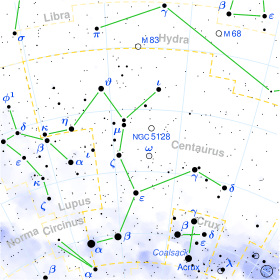B Centauri
B Centauri is a single[6] star in the southern constellation of Centaurus. It has the identifier HD 102964 in the Henry Draper catalogue; B Centauri is the star's Bayer designation.[5] This object has an orange hue and is faintly visible to the naked eye with an apparent visual magnitude of +4.47.[2] The star is located at a distance of approximately 440 light years from the Sun based on parallax,[1] and has an absolute magnitude of −1.14.[2]
| Observation data Epoch J2000.0 Equinox J2000.0 | |
|---|---|
| Constellation | Centaurus |
| Right ascension | 11h 51m 08.69149s[1] |
| Declination | −45° 10′ 24.4890″[1] |
| Apparent magnitude (V) | +4.47[2] |
| Characteristics | |
| Spectral type | K3III[3] |
| B−V color index | +1.283±0.052[2] |
| Astrometry | |
| Radial velocity (Rv) | +2.2±2.7[2] km/s |
| Proper motion (μ) | RA: -73.088[1] mas/yr Dec.: -8.170[1] mas/yr |
| Parallax (π) | 7.4043 ± 0.1863[1] mas |
| Distance | 440 ± 10 ly (135 ± 3 pc) |
| Absolute magnitude (MV) | −1.14[2] |
| Details | |
| Mass | 1.16[4] M☉ |
| Radius | 39.02+1.20 −5.37[1] R☉ |
| Luminosity | 480.1±13.8[1] L☉ |
| Surface gravity (log g) | 1.32[4] cgs |
| Temperature | 4,325+251 −65[1] K |
| Metallicity [Fe/H] | −0.03[4] dex |
| Other designations | |
| Database references | |
| SIMBAD | data |
This object is an aging giant star with a stellar classification of K3III,[3] indicating the star has exhausted the supply of hydrogen at its core then cooled and expanded off the main sequence. At present it has 39 times the girth of the Sun. It is radiating 480 times the luminosity of the Sun from its enlarged photosphere at an effective temperature of 4,325 K.[1]
References
- Brown, A. G. A.; et al. (Gaia collaboration) (August 2018). "Gaia Data Release 2: Summary of the contents and survey properties". Astronomy & Astrophysics. 616. A1. arXiv:1804.09365. Bibcode:2018A&A...616A...1G. doi:10.1051/0004-6361/201833051. Gaia DR2 record for this source at VizieR.
- Anderson, E.; Francis, Ch. (2012), "XHIP: An extended hipparcos compilation", Astronomy Letters, 38 (5): 331, arXiv:1108.4971, Bibcode:2012AstL...38..331A, doi:10.1134/S1063773712050015.
- Houk, Nancy (1978), Michigan catalogue of two-dimensional spectral types for the HD stars, 2, Ann Arbor: Dept. of Astronomy, University of Michigan, Bibcode:1978mcts.book.....H.
- Anders, F.; Khalatyan, A.; Chiappini, C.; Queiroz, A. B.; Santiago, B. X.; Jordi, C.; Girardi, L.; Brown, A. G. A.; Matijevič, G.; Monari, G.; Cantat-Gaudin, T.; Weiler, M.; Khan, S.; Miglio, A.; Carrillo, I.; Romero-Gómez, M.; Minchev, I.; De Jong, R. S.; Antoja, T.; Ramos, P.; Steinmetz, M.; Enke, H. (2019). "Photo-astrometric distances, extinctions, and astrophysical parameters for Gaia DR2 stars brighter than G = 18". Astronomy and Astrophysics. 628: A94. arXiv:1904.11302. Bibcode:2019A&A...628A..94A. doi:10.1051/0004-6361/201935765.
- "B Cen". SIMBAD. Centre de données astronomiques de Strasbourg. Retrieved 2020-03-02.
- Eggleton, P. P.; Tokovinin, A. A. (September 2008), "A catalogue of multiplicity among bright stellar systems", Monthly Notices of the Royal Astronomical Society, 389 (2): 869–879, arXiv:0806.2878, Bibcode:2008MNRAS.389..869E, doi:10.1111/j.1365-2966.2008.13596.x.
